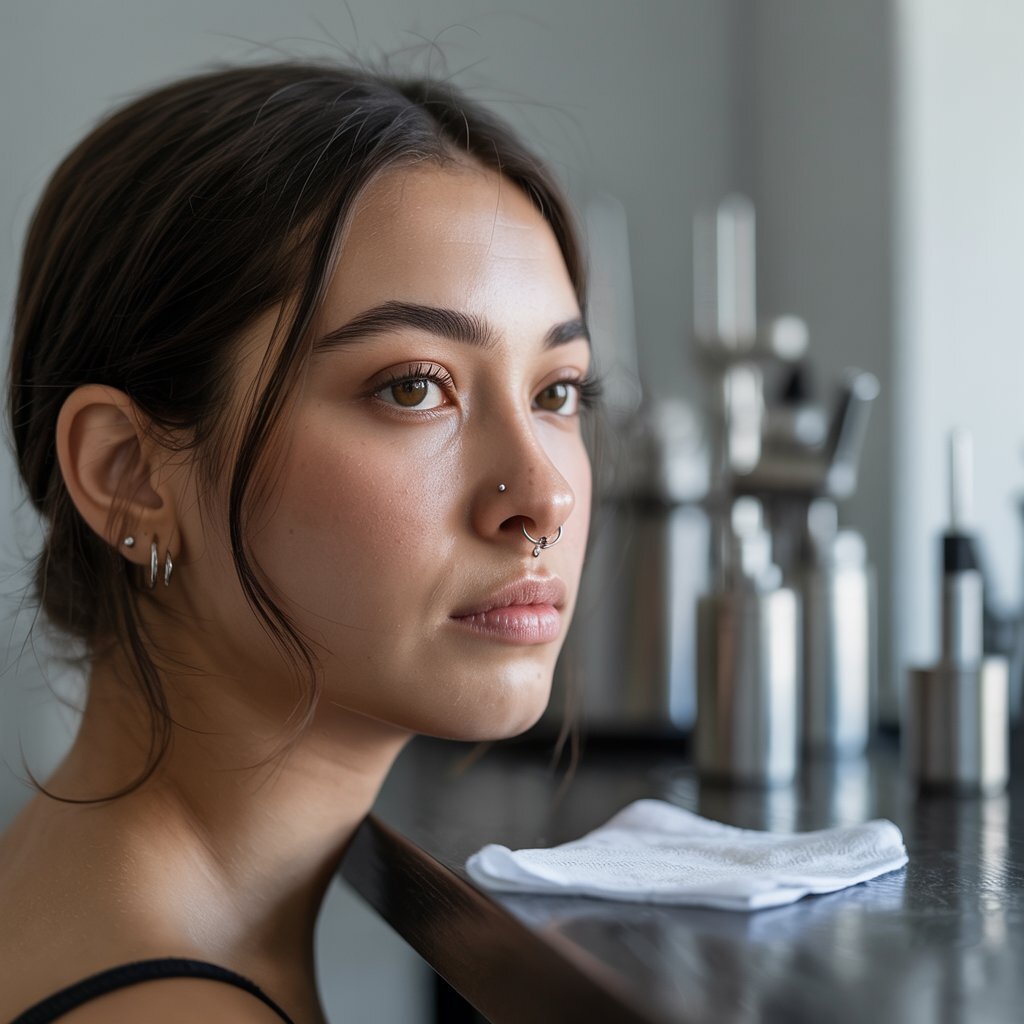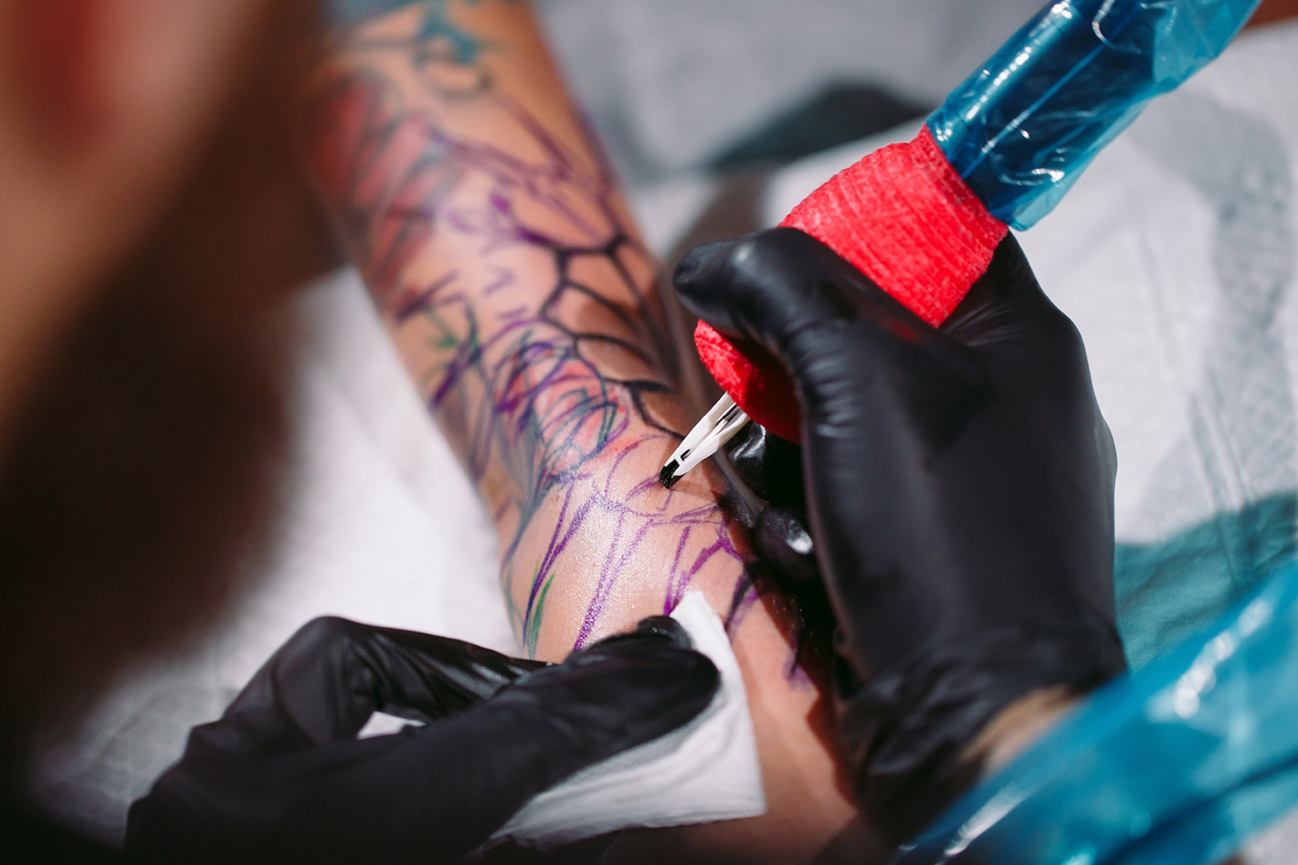Got a new nose piercing and can’t wait to switch out that starter jewelry? Hold up. Changing your nose piercing too early could turn your dream piercing into a painful nightmare that takes months to fix.
At Platinum Ink Tattoo & Body Piercing, we’ve seen many clients rush the healing process only to end up with irritated, infected, or bumpy piercings. After over two decades in Austin’s body art scene, we know the difference between a healed piercing and one that just looks ready.
This guide will show you exactly when it’s safe to change your nose piercing, what signs to watch for, and how to avoid the common mistakes that derail healing. Let’s protect your investment and keep your piercing looking perfect.
How Long Does a Nose Piercing Take to Heal?
Your nose piercing isn’t actually healed when it looks healed. This is the biggest misconception we hear at our studio. While the outside might appear fine after a few weeks, the internal healing process takes much longer.
Nostril piercings typically require 2-4 months for initial healing, but full maturation of the internal channel (called the fistula) can take 6-9 months or even longer. Think of it like a tunnel – the entrance and exit might look finished, but the walls inside are still under construction.
Septum piercings heal faster at 6-8 weeks when placed correctly in the thin tissue between your nostrils. However, if your piercer accidentally hits cartilage during the procedure, healing time extends to 2-3 months.
The key difference? Piercings heal from the outside in. That pink, healthy-looking exterior can be deceiving when the inside is still vulnerable and forming scar tissue.
Here’s what professional piercers know: “Most people have to wait at least a year for the fistula to fully mature. General healing time is 6-9 months.”
Ready to upgrade your jewelry collection? Browse our selection of high-quality nose piercing options in Austin, TX to plan your future look while you heal.
When Is It Actually Safe to Change Your Jewelry?
Wait at least 6-8 weeks minimum before attempting any jewelry changes. But here’s the truth most studios won’t tell you: waiting 6 months dramatically reduces your risk of complications.
We’ve learned this through experience. Clients who change jewelry at 8 weeks often develop irritation bumps or prolonged healing. Those who wait 6 months? Smooth sailing.
The “6-month rule” exists for good reason. As one industry expert puts it: “Wait at least 6 months before even considering changing your jewelry. You may THINK it’s healed, but it’s definitely not.”
Signs Your Piercing Is Ready for Change:
- No pain, soreness, or tenderness when touching the area
- Zero discharge (clear or otherwise) for several weeks
- Jewelry moves freely without resistance or discomfort
- No redness or swelling around the piercing site
- No crusty buildup that requires daily cleaning
Red Flags – Don’t Change Yet:
- Any pain when the jewelry moves
- Morning crustiness that needs cleaning
- Redness or irritation around the holes
- Recent bumps or swelling
- Discharge of any color
Pro tip: If you’re unsure, visit your piercer for a professional assessment. We’d rather check your healing than fix complications later.
Best Materials for Your First Jewelry Change
Titanium is your best friend during healing. Specifically, look for ASTM F-136 implant-grade titanium – the same material used in medical implants.
Why titanium wins:
- 100% hypoallergenic (no nickel content)
- Lightweight so it won’t pull on healing tissue
- Corrosion-resistant in body fluids
- Available in colors through safe anodization
Solid 14k or 18k gold makes a great alternative for those wanting luxury looks, but only if you’re not sensitive to metals. Avoid gold-plated jewelry – the plating wears off and can cause reactions.
Material Comparison:
| Material | Best For | Avoid If |
| Implant-grade Titanium | Everyone, especially sensitive skin | You want a gold look |
| Solid 14k/18k Gold | Healed piercings, style preference | You have metal sensitivities |
| Surgical Steel | Budget-conscious (short term) | You’re nickel sensitive |
Never use sterling silver in healing piercings – it can cause permanent discoloration called argyria.
At Platinum Ink, we stock only the highest quality jewelry because we’ve seen too many beautiful piercings ruined by cheap materials.
Stud vs. Hoop: Which Should You Choose First?
Start with studs, graduate to hoops. This isn’t just preference – it’s about physics and healing success.
Studs provide stability that healing tissue needs. They don’t rotate, twist, or catch on things as easily. L-shaped studs work particularly well for nostrils because they’re secure without being too tight.
Hoops look amazing but create problems during healing:
- They move too much, irritating the healing channel
- They’re easier to snag on clothing or hair
- The constant motion can cause bumps or delay healing
Save the hoop dreams for after 6 months when your piercing can handle the movement. Trust us – patience pays off with better long-term results.
“I always tell my clients a full 6 months. There’s more tissue there than you think. And while everyone is different, everything heals from the outside in.”
Warning Signs: When Something’s Wrong
Normal healing includes some redness and swelling for the first 1-2 weeks. Your body is responding to the wound, which is expected.
Watch for these warning signs:
Infection Red Flags:
- Yellow or green discharge with a foul smell
- Severe pain that worsens instead of improving
- Fever or feeling unwell
- Red streaks extending from the piercing
- Excessive swelling that doesn’t subside
Irritation Bumps vs. Serious Issues:
Irritation bumps are pink, dry, and usually painless. They’re your body’s way of saying “something’s bothering me” – often from touching, sleeping on the piercing, or poor quality jewelry.
Keloids are raised, dark scars that grow beyond the original piercing site. They’re more common in certain skin types and require professional treatment.
If you see pus, smell odor, or have severe pain, don’t wait. Contact a healthcare provider immediately. Early treatment prevents serious complications.
Essential Aftercare for Faster Healing
Clean twice daily with saline solution – not homemade salt water, but proper wound wash from the pharmacy.
Your daily routine should include:
- Wash your hands before touching the piercing
- Spray or apply saline to the front and back
- Gently pat dry with clean paper towels
- Leave it alone the rest of the day
What NOT to Do:
- Don’t use alcohol or hydrogen peroxide – they dry out tissue
- Don’t apply ointments or oils during healing
- Don’t twist or rotate the jewelry
- Don’t sleep on the piercing
- Avoid spicy foods and alcohol initially to reduce irritation
Recent 2025 guidelines emphasize patience above all. Rushing aftercare or changing products frequently does more harm than good.
The piercing will heal – your job is simply not to interfere with the process.
Nostril vs. Septum: What’s the Difference?
Nostril piercings offer more jewelry variety but take longer to heal due to thicker tissue. Full healing typically takes 4-6 months, with high nostril piercings extending to 6-9 months.
Septum piercings heal faster (6-8 weeks) when placed in the “sweet spot” – the thin membrane between your nostrils. The key advantage? You can flip them up to hide them during healing or for work.
Nostril Piercing Tips:
- Choose L-shaped studs for initial jewelry
- Expect longer healing times but more style options later
- Side sleeping can cause irritation – use a travel pillow
Septum Piercing Tips:
- Horseshoe rings allow flipping up for discretion
- Proper placement is crucial – improper placement in cartilage extends healing
- Less visible swelling compared to nostril piercings
Both types benefit from identical aftercare, but septums typically cause fewer complications due to their location and faster healing.
What Happens If You Change Too Early?
Changing jewelry before full healing can restart the entire process. We’ve seen clients turn a 3-month healing journey into a 12-month struggle by switching jewelry too soon.
Common complications include:
- Irritation bumps that take weeks to resolve
- Infection from introducing bacteria during the change
- Partial closure requiring re-piercing
- Scar tissue formation that makes future changes difficult
The most frustrating part? These problems are completely avoidable by simply waiting for proper healing.
“If your piercing hurts after 6, 7, or 8 months, it is almost always due to irritation. This can be caused by changing the jewelry too soon.”
Even if your piercing looks perfect at 2 months, the internal tissue is still forming. That disruption can cause weeks of setbacks and unnecessary discomfort.
Your Next Steps to Perfect Healing
Your nose piercing journey doesn’t have to be complicated. Follow the 6-month rule, stick with quality materials, and listen to your body.
Remember these key points:
- Wait 6 months minimum for jewelry changes
- Choose implant-grade titanium for your first swap
- Start with studs, upgrade to hoops later
- Clean twice daily with saline solution
- Seek help immediately if you notice infection signs
At Platinum Ink Tattoo & Body Piercing, we’re here to support your healing journey from start to finish. Our experienced piercers can assess your healing progress and recommend the best jewelry for your lifestyle.
Ready to plan your jewelry upgrade? Stop by our Austin studio for a complimentary healing check and explore our premium jewelry selection. Your future self will thank you for the patience.
Frequently Asked Questions
Can I change my nose piercing after 2 months? While some piercings may appear healed at 2 months, we recommend waiting at least 6 months to avoid irritation and complications. Changing too early often leads to bumps and prolonged healing.
What’s the best first jewelry to change to? Implant-grade titanium studs are ideal for your first change. They’re hypoallergenic, lightweight, and provide stability while your piercing continues maturing.
How do I know if my nose piercing is fully healed? A fully healed piercing has no pain, discharge, redness, or swelling. The jewelry should move freely without discomfort, and you shouldn’t need daily cleaning anymore.
Can I sleep on my nose piercing during healing? Avoid sleeping on fresh piercings as pressure can cause irritation and bumps. Use a travel pillow or sleep on the opposite side until fully healed.
What should I do if I notice a bump on my nose piercing? Small pink bumps are usually irritation from movement or touching. Maintain proper aftercare and avoid manipulating the area. If the bump has pus, odor, or severe pain, consult a healthcare provider.
Is it normal for my nose piercing to still hurt after 3 months? Some tenderness can be normal, but persistent pain after 3 months often indicates irritation from premature jewelry changes, poor quality materials, or inadequate aftercare. Have a professional assess the piercing.




